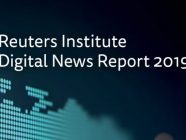Data are now abundant, and governments, companies, media, and organisations are constantly seeking to reap the benefits of these data – whether to identify internal issues and consider potential solutions, to improve transparency, or to communicate findings to clients or other consumers, writes Malu A C Gatto, D Phil Politics at the University of Oxford.
Although evidence has always been the basis of academic research, disseminating findings with non-academics has not.
Data visualisation is thus an important research and dissemination tool. Academics, however, have been falling behind in training on data visualisation, as well as in efforts to increase the dissemination and impact of their research.
As an attempt to gain further understanding of how academic, government, policy, media, and business leaders currently use data visualisation, the Reuters Institute for the Study of Journalism and the Department of Politics and IR of the University of Oxford, together with the Alliance for Useful Evidence (a partnership between Nesta, the Big Lottery Fund, and the Economic and Social Research Council) carried out the project that titles the report ‘Making Research Useful: Current Challenges and Good Practices in Data Visualisation’. The project, funded by an ESRC Impact Acceleration Award, and led by Professor Robert G. Picard at the Reuters Institute, was structured around three workshops that brought together data visualisation experts from the media, policy, and business spheres, as well as a number of academics, and other individuals eager to learn more about the theory and practice of data visualisation. The report summarises and further develops on the most pressing discussions of the workshops.
It argues that data visualization can improve understanding of data for both researchers and their audiences and that, as such, academics can use it as a tool for theory refining and testing, as well as a means of disseminating findings. As such, it advocates for the use data visualisation in academia and suggests a number of ways in which social scientists can “catch up” with developments of data visualisation taking place outside of academia.
The publication also offers explanations of some of the most common challenges academics currently face to using data visualisation, and provides suggestions to overcome some of these problems. Challenges identified include: knowledge gaps, the variety of types and forms of data used, the availability, training, and limitations of specific software typically learned and used by social scientists, and publication guidelines and limitations; some solutions outlined are: becoming more knowledgeable about good practice in data visualisation, and seeking to enhance their visualisation capabilities through training and collaboration beyond-academia.
To interest academics in data visualisation, the publication also includes descriptions and uses of common types of graphics, a list of useful blogs, and suggestions for further reading; it also offers a comprehensive list of free software and online platforms that can be used to produce data visuals, as well as options for free online training.
– See more at: https://reutersinstitute.politics.ox.ac.uk/publication/making-research-useful#sthash.Cr9k5NQh.dpuf
Photo credit: Flickr Creative Commons: Mario Klingemann
Tags: academic research, data visualisation, digital news, Research, Reuters Institute for the Study of Journalism














































